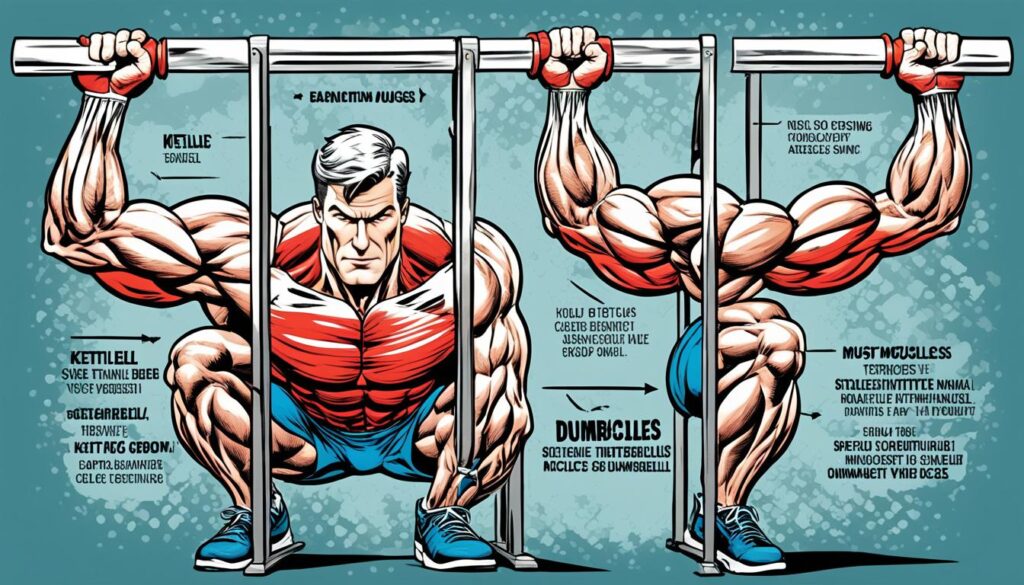Exploring kettlebell swing muscles worked
Did you know that a single kettlebell swing workout can activate and engage more than 600 muscles in your body?
Yes, you read that right! This seemingly simple exercise has the power to work your entire body, leaving no muscle untouched. From your legs to your core, and even your arms and shoulders, the kettlebell swing demands a well-coordinated effort from multiple muscle groups.
Key Takeaways:
- The kettlebell swing is a highly efficient exercise that targets over 600 muscles in your body.
- By incorporating kettlebell swings into your fitness routine, you can achieve a full-body workout in a short amount of time.
- The primary muscles worked during kettlebell swings include the glutes, hamstrings, and core.
- Kettlebell swings also engage secondary muscles in the shoulders, back, and arms, providing additional strength and stability.
- Adding kettlebell swings to your dumbbell workouts can enhance overall muscle development and functional fitness.
Understanding the mechanics of kettlebell swings
Before we dive into the specific muscles worked, it’s important to understand the mechanics of the kettlebell swing exercise. In this section, we will explore the proper form and technique to ensure maximum effectiveness and safety during your swings.
When performing a kettlebell swing, the movement primarily originates from the hips. It involves a powerful hip hinge and a quick snap of the hips forward to generate momentum. The arms act as a dynamic link, allowing the kettlebell to swing freely between the legs and up to chest level.
To execute a kettlebell swing correctly:
- Stand with your feet shoulder-width apart and grasp the kettlebell with both hands.
- Set your hips back and hinge forward at the waist, maintaining a neutral spine.
- Engage your glutes and hamstrings, and explosively drive your hips forward, swinging the kettlebell forward.
- As the kettlebell reaches its peak position, let it swing back between your legs while maintaining control.
- Repeat the movement in a fluid and controlled manner, focusing on the explosive hip thrust.
Proper technique is essential in kettlebell swings to prevent injuries and maximize the benefits. It’s important to avoid using your arms to lift the kettlebell, as this can strain the shoulders and detract from the intended muscle engagement. Instead, let the momentum generated by the hip snap propel the kettlebell.
Note: Maintaining a strong core and bracing your abs throughout the movement will help stabilize your spine and minimize stress on your lower back.
Benefits of proper mechanics
Understanding and executing the correct mechanics of kettlebell swings offer several benefits:
- Increased power and explosiveness: The hip-driven movement recruits the powerful hip extensor muscles, such as the glutes and hamstrings, improving explosive strength and power.
- Enhanced cardiovascular fitness: The dynamic and rhythmic nature of kettlebell swings elevates heart rate, providing an effective cardiovascular workout.
- Improved muscular endurance: By engaging multiple muscle groups and performing high-repetition sets, kettlebell swings develop muscular endurance and stamina.
- Functional movement patterns: The hip hinge motion in kettlebell swings mimics everyday movements like lifting objects and enhances overall functional fitness.
- Efficient time investment: Kettlebell swings offer a time-efficient workout option, engaging numerous muscles in a single exercise.
Primary muscles worked during kettlebell swings
The kettlebell swing is an exceptional exercise that targets multiple muscle groups simultaneously, providing a dynamic full-body workout. By incorporating kettlebell swings into your fitness routine, you can effectively engage and strengthen several primary muscles, including the glutes, hamstrings, and core. Let’s explore the role of these muscles in detail:
The Glutes
The gluteus maximus, medius, and minimus, commonly known as the glutes, are the largest muscles in the buttocks. They play a vital role in hip extension and stabilization during kettlebell swings. The explosive movement of swinging a kettlebell activates the glutes, helping to strengthen and tone these muscles.
The Hamstrings
The hamstrings, located at the back of the thighs, are heavily engaged during kettlebell swings. They act as important hip extensors, working alongside the glutes to propel the kettlebell forward. By regularly performing kettlebell swings, you can develop stronger and more powerful hamstrings.
The Core
The core muscles, including the rectus abdominis, obliques, and lower back muscles, form the foundation of stability and strength during kettlebell swings. As you swing the kettlebell between your legs and then powerfully extend your hips, your core muscles contract to maintain proper alignment and provide stability. The kettlebell swing is an effective exercise for strengthening and toning the core.
In addition to targeting these primary muscles, kettlebell swings also provide a functional and complementary benefit to other exercises, such as lifts and squats. The explosive hip extension and activation of the glutes and hamstrings during kettlebell swings can enhance overall performance and power in these lifts and squats.
Now that we’ve covered the primary muscles worked during kettlebell swings, let’s explore the involvement of secondary muscle groups in the next section.
| Primary Muscles | Role |
|---|---|
| Glutes | Act as hip extensors and provide power |
| Hamstrings | Aid in hip extension and generate force |
| Core | Maintain stability and alignment |
Additional muscles engaged during kettlebell swings
While the primary focus of kettlebell swings is on targeting the glutes, hamstrings, and core, there are also several secondary muscles that come into play to provide support and stability during the exercise. Incorporating kettlebell swings into your dumbbell workouts can help you engage these additional muscles and enhance your overall strength and power.
Shoulders
The deltoids, or shoulder muscles, play a crucial role in kettlebell swings. As you swing the kettlebell upwards, the deltoids contract to stabilize and control the movement, ensuring proper alignment and shoulder positioning. This engagement of the shoulders not only strengthens the deltoids but also improves shoulder mobility and stability.
Back
The back muscles, including the lats, rhomboids, and trapezius, are also activated during kettlebell swings. These muscles work together to maintain posture and control the movement of the kettlebell. As you hinge at the hips and swing the kettlebell back, the back muscles engage to prevent excessive rounding of the spine and promote proper spinal alignment.
Arms
Kettlebell swings can provide a great workout for the arms, specifically the biceps and forearms. As you swing the kettlebell up, your arms act as a connecting link between the powerful hip extension and the upward momentum of the kettlebell. This repetitive movement helps to strengthen and tone the arm muscles, enhancing grip strength and overall upper body stability.
By engaging these additional muscles, kettlebell swings offer a comprehensive full-body workout that targets both the primary and secondary muscle groups. The combination of dynamic movements and multi-muscle involvement makes kettlebell swings an efficient exercise for building strength, power, and endurance.

Additional Muscles Engaged During Kettlebell Swings
| Muscle Group | Role |
|---|---|
| Shoulders (deltoids) | Stabilize and control the movement |
| Back (lats, rhomboids, trapezius) | Maintain posture and control the kettlebell swing |
| Arms (biceps, forearms) | Act as a connecting link and enhance upper body stability |
Conclusion
In conclusion, the kettlebell swing is an incredibly effective exercise that targets a wide range of muscles throughout the body. Whether you’re aiming to strengthen your glutes and core or engage your arms and shoulders, incorporating kettlebell swings into your fitness routine can provide numerous benefits.
The primary muscles worked during kettlebell swings include the glutes, hamstrings, and core. These muscles are essential for maintaining proper posture, generating power, and improving overall stability. By regularly incorporating kettlebell swings into your workouts, you can strengthen these key muscle groups and enhance your performance in various exercises, including the clean jerk.
Moreover, kettlebell swings also engage secondary muscles in the shoulders, back, and arms, providing additional support and stability. This makes kettlebell swings an excellent complement to dumbbell workouts and other strength training exercises.
So, whether you’re a beginner or an experienced lifter, don’t overlook the kettlebell swing. Embrace the dynamic movements, activate multiple muscle groups, and experience the transformative power it brings to your fitness journey. Start swinging your way to a stronger, more functional physique today!
FAQ
What muscles are worked during a kettlebell swing?
The kettlebell swing is a dynamic exercise that targets a variety of muscles, including the glutes, hamstrings, core, and shoulders. It is a highly effective full-body workout.
What is the proper form and technique for kettlebell swings?
To perform kettlebell swings correctly, start with your feet shoulder-width apart, hinge at the hips, and maintain a slight bend in the knees. Swing the kettlebell back between your legs and forcefully drive your hips forward to propel the weight up to shoulder height.
Can kettlebell swings complement other lifts and squat exercises?
Yes, kettlebell swings can be a great addition to your workout routine to enhance other lifts and squat exercises. They help improve power, explosiveness, and overall athleticism.
Apart from the primary muscles, which other muscles are engaged during kettlebell swings?
In addition to the primary muscles, kettlebell swings also engage secondary muscle groups, including the shoulders, back, and arms. This makes kettlebell swings a comprehensive full-body exercise.
How can kettlebell swings benefit my dumbbell workouts?
Incorporating kettlebell swings into your dumbbell workouts adds variety and challenges your muscles in different ways. They can help improve grip strength, enhance coordination, and increase overall muscular endurance.
Can kettlebell swings improve performance in clean jerk exercises?
Yes, kettlebell swings can enhance performance in exercises like the clean jerk. The explosive hip drive and coordination required during kettlebell swings transfer well to the clean and jerk movement, helping to improve power and efficiency.
